
Much has been written and spoken about the rate of change we are experiencing at the moment, and how this is disrupting the business world.
Unfortunately this is not true; we are actually in a period of slow change approaching a period of rapid change, and if you are a business struggling now, this is as slow as change will ever be.
Why do I say this?
My grandparents were Victorians. They were born into a world of horses, steam power, and paraffin lamps. They died in a world of cars, supersonic planes, telephones, radio, television, electricity, computers and space travel. That’s change.
Since then, we have got better phones, better computers, better cars (but returning to electric power), better planes (but slower), more frequent space travel (but less ambitious).
The biggest technological change has been in computing power and the internet, but up to now, this has only reached about half the global population.
On the cusp
We are now just entering a period of more rapid change driven by reaching a tipping point with the internet where it will be available to the vast majority of people, and the massive impact of the current mainstream approach to economics has become so large on the environment and society that they cannot be ignored.
The economic crash of 2008 proved the limitations of this current economic model and spurred interest in new ways of viewing economics. One of these that appears to have generate much discussion is Kate Raworth’s Doughnut Model :

Figure 1 : The Doughnut of social and planetary boundaries (2017)
For me, another one of the ‘tells’ that there has not been large scale change is that the corporate model, started a little over 100 years ago, is just starting to come under pressure. In other words, there has been so little change that the model of organising and running businesses has not had to alter too much since the 1920s.
The current Covid-19 pandemic is rapidly testing people’s assumptions about what ‘normal’ is, and forcing organisations to change how they work. It will be interesting to see how many will keep some of their changes going forward.
Disruption
Now the word of the moment in business is ‘disruption’. Venture capital pitch decks are awash with Uber-like proposals promising to disrupt one industry or another. However, to my mind, true disruption is a rare commodity; what really exists is the inability of competitors to respond fast enough. A business strategy, or event, is only disruptive if it catches people out and they cannot react. The same approach used against a nimble competitor would not be as effective. The problem is not the speed of disruption, rather it is the slowness of change.
Why can’t organisations change fast enough
Key to this is the previous hypothesis, that we have been in a period of stability not change. This means that a view of business based on maximising value extraction has been able to develop, including such practices as leaning, cost-reductions, outsourcing, and centralisation. By aligning a business so closely with the current environment, it makes any change in that environment very difficult to cope with - there is no ‘waste’ in the system to accommodate change, contracts, processes, physical and digital environments assume current conditions, as do roles and incentives.
Critically, senior management have all been hired to maximise shareholder returns, not necessarily guard long-term survivability. Essentially, most companies seem to have assumed that they can follow their own strategy and do not need to change, so they have lost the ability to do so. Not being able to change now makes them very vulnerable.
Adaptive organisations
Adaptive is a broad term to describe organisations that can change themselves through normal operation rather than relying on transformation initiatives. It is important that this change is not just change at the team level such as changing the sprint length, it is organisational change such as roles, finance, governance, business model, size, industry etc.
Some organisations need to be more responsive than others, therefore some are more adaptive than others.
Because of this range of possibilities it is no single Adaptive organisational form, there is a spectrum of organisational forms and different realisations of each form, but they will trend from left to right on the characteristics below as they become more adaptive:
(Adapted from Corporate Rebels )
So if we agree that organisations will have to change to survive in an increasingly turbulent business environment, how can the actually achieve that?
I see that there are three main areas to enable change, and indeed create change, and they are:
The lowest level of change adoption is, and always has been, the individuals who work for an organisation. Whether it is adopting new technology, make sense of disjoint corporate policies and practices or keeping delivering during staff changes, it is the people who make it work.
During the current COVID-19 pandemic we are seeing some of the best of this as people are rapidly figuring out how to keep businesses running and volunteering to help out where they can.
In a changeable world, we want to not only keep this ability, but enhance it. This can be enabled by:
All change is based on people, they need to be empowered and enabled.
The next level of flexibility is via product change - altering their products and services to react to, or drive, change. To do this an organisation needs to be able to deliver a continuous flow of ideas and new products. Kent Beck’s 3X framework outlines this:
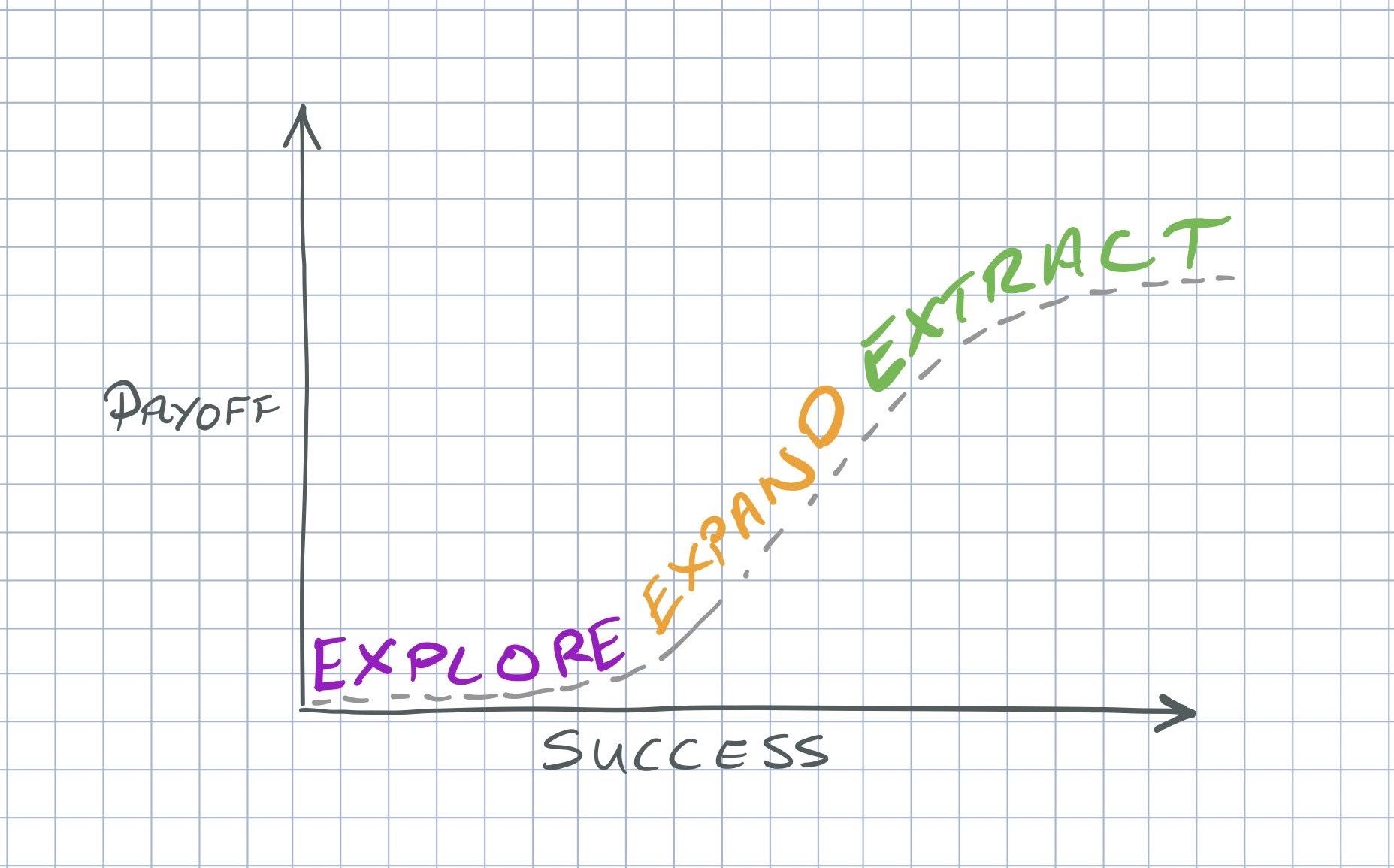
Figure 2 : Explore, Expand, Extract
(Potentially there could be a fourth stage
By flowing products through these stages a company can keep a balanced portfolio of new and mature products.
The ability to identify and create new products or features enables an organisation to adjust and respond to the competitive environment.
Many organisations struggle with this due to the mind-set of their leaders which has focussed on the last, Extract, phase. By building organisations around extraction, they build environments in which the rather more risky and ‘woolly’ Explore and Expand phases struggle to be effective, if they exist at all.
There is a current trend of large organisations buying smaller, more innovate companies such as design agencies or digital media companies, in an attempt to buy in the ability to perform these earlier phases. In my experience this rarely works because each of the phases needs different mindsets and environments to make them work. The mindset needed for the more design led phases gets ‘optimised’ out by the culture of the larger parent organisations.
Simon Wardley uses the following archetypes to capture the differences between the mindsets needed:
The following definitions are taken straight from his article ‘Pioneers, Settlers, Town Planners’ :
”Pioneers are brilliant people. They are able to explore never before discovered concepts, the uncharted land. They show you wonder but they fail a lot. Half the time the thing doesn’t work properly. You wouldn’t trust what they build. They create ‘crazy’ ideas. Their type of innovation is what we call core research. They make future success possible. Most of the time we look at them and go “what?”, “I don’t understand?” and “is that magic?”. In the past, we often burnt them at the stake. They built the first ever electric source (the Parthian Battery, 400AD) and the first ever digital computer (Z3, 1943).
Settlers are brilliant people. They can turn the half baked thing into something useful for a larger audience. They build trust. They build understanding. They make the possible future actually happen. They turn the prototype into a product, make it manufacturable, listen to customers and turn it profitable. Their innovation is what we tend to think of as applied research and differentiation. They built the first ever computer products (e.g. IBM 650 and onwards), the first generators (Hippolyte Pixii, Siemens Generators).
Town Planners are brilliant people. They are able to take something and industrialise it taking advantage of economies of scale. This requires immense skill. You trust what they build. They find ways to make things faster, better, smaller, more efficient, more economic and good enough. They build the services that pioneers build upon. Their type of innovation is industrial research. They take something that exists and turn it into a commodity or a utility (e.g. with Electricity, then Edison, Tesla and Westinghouse). They are the industrial giants we depend upon. What you want is brilliant people in each of these roles.”
Joining the two together:
Each of these groups, and types of work, need their own:
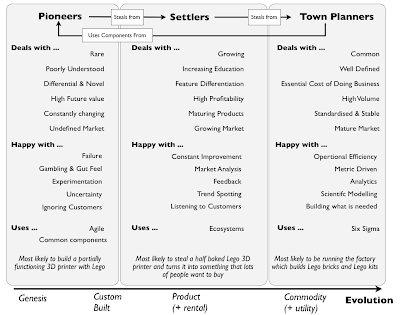
Figure 3 : Pioneers, Settlers and Town Planners
Unfortunately, most senior managers are Town Planners. The view of companies today, therefore, is that businesses are about the exploitation of existing knowledge, skills, products and services. The Town Planner lens gets applied to the whole business. In stable times this might work, but in unstable times it won’t.
You cannot cost-cut your way to new innovations. Laying people off to meet the quarterly stock price target will not build a loyal and a dedicated workforce willing to weather a storm together, or take risks on new ideas.
If you are mass producing something this is the mind set to have, but optimising out new innovation and experimentation, strangles the ability to adapt and change to disruptive competition.
Product Flow As illustrated in Figure 2, products flow from being new ideas to mature, commoditised offerings. Sometimes this is a planned product journey which has the goal of maturing a product; the development of new products is seen as a cost, with profits only really emerging once the products is commoditised - think mass-market cars, toys or computer games.
Sometimes the goal is not to take a product all the way to commoditisation. Once a offering is commoditised, it is harder to make big profit from each individual sale. Companies can choose to occupy this middle space, where new ideas have been proven but not yet commoditised. This is where small scale production exists such as hyper cars and companies like 3M who create product ideas but outsource production. This is also where management consultancies live. There are also organisations that thrive as idea factories such as IDEO.
Staying at a particular stage of the product lifecycle is a conscious decision, and often hard fought for. Any successful new product will be picked up by others to be commoditised; [Wardley Maps] use the idea that products tend to flow towards commoditisation over time. An organisation resisting this flow must either legally protect their idea/product or continually create/adopt new ones as the existing ones flow to the right. In this way organisations either adapt on their own, or are forced to. Either way they have to adapt.
Organisations need to understand what their mission is, what type of people they need to deliver this mission sustainably (Pioneers, Settlers, Town Planners), what type of organisational environments they need to enable these different groups of people to be successful and, critically, how flow is established between these groups.
Joining up the product flow can enable an organisation to flex and innovate its products to cope with a level of wider change, but it may also be possible to alter how to derive value from your products.
The business model covers quite a number of areas including:
This is the area of pivoting - can we use our product and knowledge in a new market and/or change the positioning? For instance: mouthwash was originally created to be a surgical antiseptic before creating the oral hygiene market, Kelloggs Cornflakes were originally a health food for sanitarium patients, while the UK Guardian newspaper removed their online paywall and instead asked for donations and computer manufactures occasionally change their microchip suppliers.
Flexing in the business model enables an organisation to gain more returns from an existing idea.
Joining up the product flow can enable an organisation to flex and innovate its products to cope with a level of wider change, but there are supporting services which are needed to be aligned for the products to be successfully produced, sold, maintained.
Mapping the value chain provides visibility of components required to deliver products:
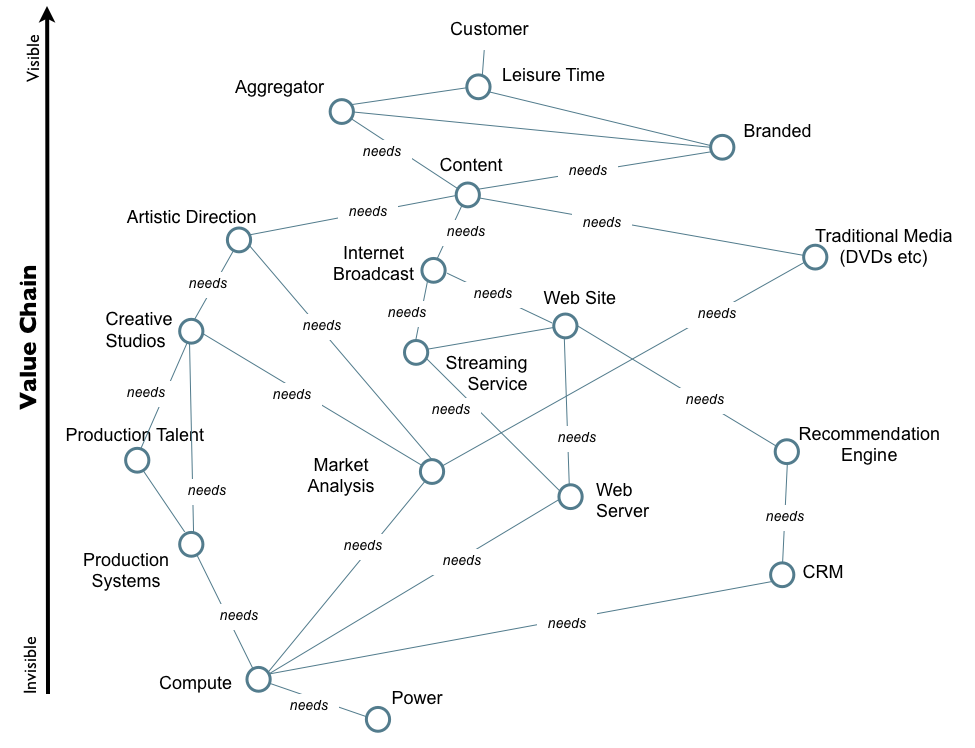
Figure 4: Value Chain
Wardley maps add an additional dimension - evolution. This indicates the certainty of each component, plus where we believe we can add value

Figure 5: Wardley Map
Items on the left are more novel, uncertain and changing. Items on the right are stable and commoditised.
This leads to the identification of how each component can be delivered:
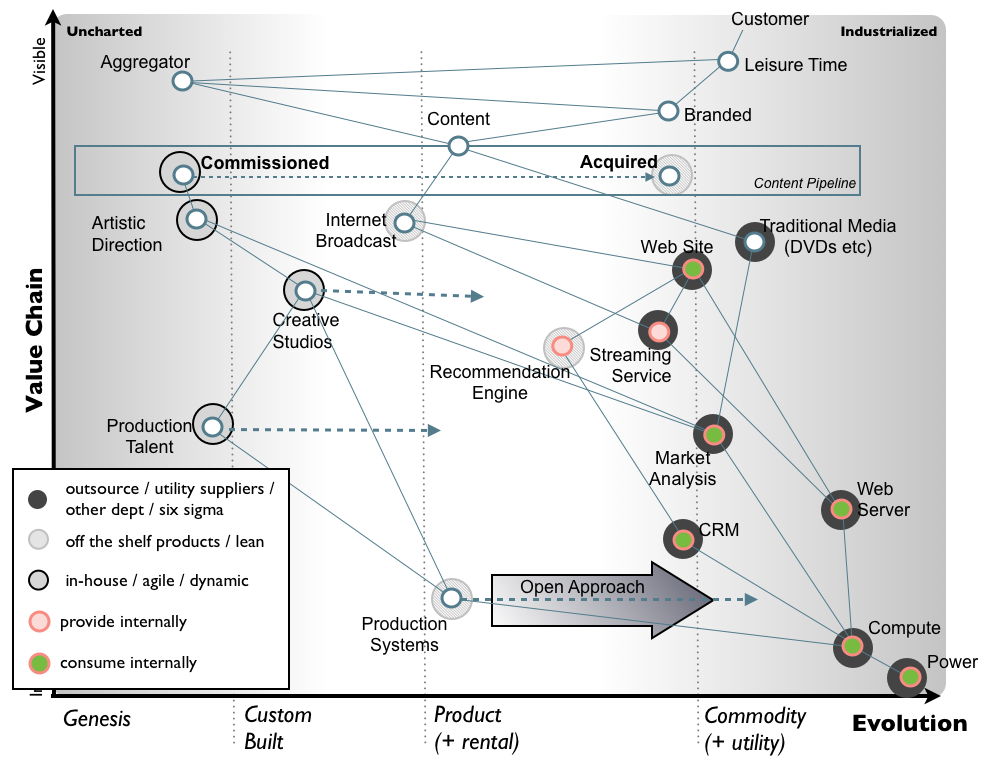
Figure 6: Methods
Teams can be identified to deliver these components. Teams owning items on the left are better suited to being pioneers, while those on the left better suited to be town planners.

Figure 7: Team Identification
We can now see a potential organisational team structure to deliver the value:
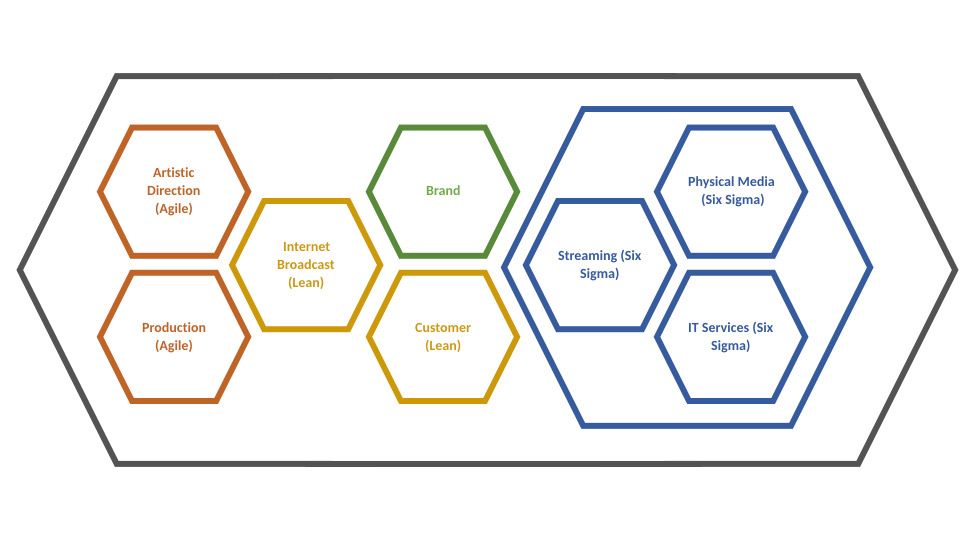
Figure 8: Team Organisation
The value chain has teams which are following different delivery methods, have different physical and technical environments, bur are aligned in purpose.
We have some flexibility in the use of more agile methods in the teams involved with areas of innovation and uncertainty, but how else do we get oganisational flexibility?
Distributed shared services
If there are shared services then they could, and normally are, centralised for efficiency and used by multiple value chains.
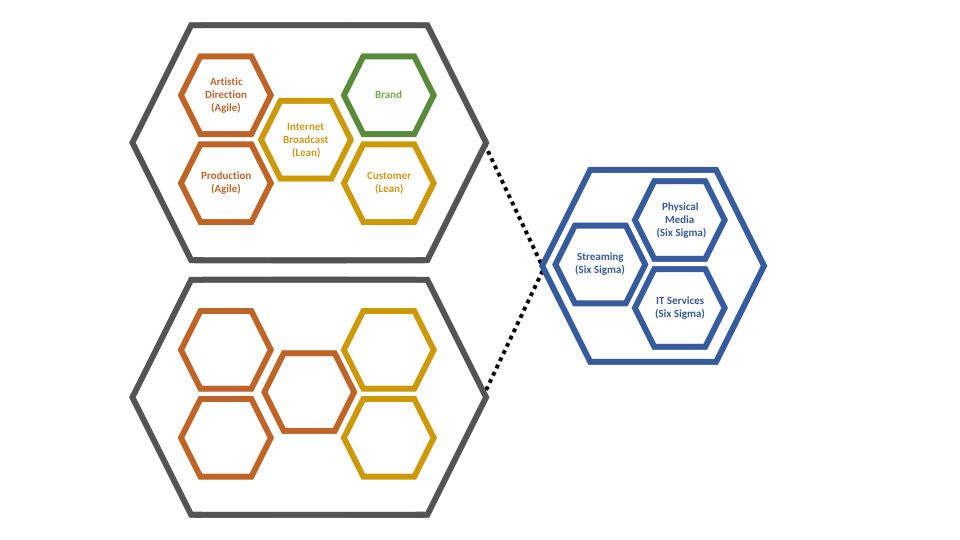
Figure 9: Shared Service
However, if a value chain would benefit from having a more responsive instance of a generally shared service, then a local instance of that service can be set up in that more responsive chain so they can bring specialist skills to the chain and be close enough to flex as needed. Examples of where this could be used are IT services for an innovative value chain which uses novel equipment, or a legal team for a value chain operating in a specialised regulated industry. To keep the overall service aligned to that service’s values, core skills and community, all the instances of a service belong to that service’s organisation-wide Community of Practice.

Figure 10: Community of Practice
Distributed decision making
Both product development and organisational structures will change over time. To enable this to happen in a timely manner decision making has to be distributed throughout the organisation. Which decisions can be made at what level is dependent on the level of adaptiveness being aimed for. The more adaptive an organisation the more decisions have to be made closer to the action.
The worry that leadership often have with this is how to prevent the decisions being made across the organisation spiralling the organisational elements away from each other fragmenting the organisation. There are some key factors to help mitigate this:
Also keep in mind that a group moving in a different direction is not necessarily always bad, it may be because that they have discovered a new vein of value which they are following. Regular communication will establish whether this is something for the organisation to get behind or dissuade.
I hope this post gives some idea about how we can start to form organisations into aligned, cross-skilled, groups to target value, and how they can stay as aligned as they need to. Rather than rigid hierarchies, organisations can be a corporate collection of flexible cells discovering and exploiting opportunities.